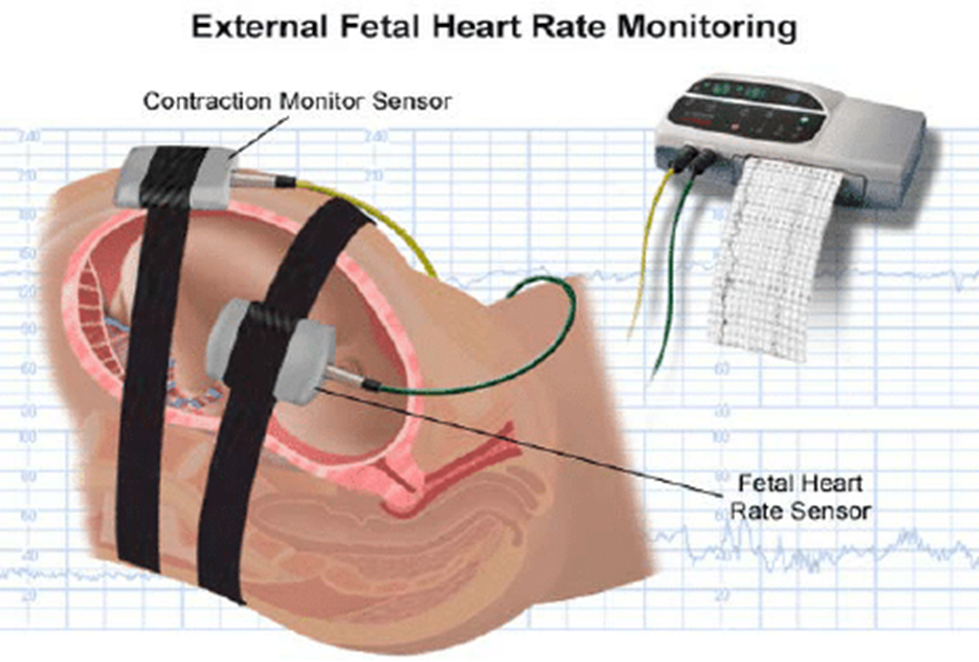A nurse is caring for a client who is pregnant and has suspected placenta previa. Which of the following should the nurse monitor the client for?
Large amount of bright red vaginal bleeding
Severe pain with no bleeding
High-grade fever
Sudden sharp pain in the lower abdomen
The Correct Answer is A
Choice A rationale:
Large amount of bright red vaginal bleeding is the cardinal sign of placenta previa. This is because the placenta is abnormally positioned low in the uterus, covering the cervix partially or completely. When the cervix starts to dilate in preparation for labor, it can detach from the uterine wall, leading to significant bleeding. The blood is typically bright red, indicating fresh bleeding, and can be painless.
Severity of bleeding: The amount of bleeding can vary from spotting to massive hemorrhage, and it may start suddenly or gradually. Even a small amount of bleeding can be a sign of placenta previa and should not be ignored.
Risks of hemorrhage: Prompt recognition and management of bleeding are crucial to prevent potentially life-threatening hemorrhage for both the mother and the fetus.
Choice B rationale:
Severe pain with no bleeding is not a typical presentation of placenta previa. While some women with placenta previa may experience mild abdominal pain or cramping, severe pain without bleeding is more suggestive of placental abruption, a condition where the placenta prematurely separates from the uterine wall.
Choice C rationale:
High-grade fever is not a direct symptom of placenta previa. However, if a woman with placenta previa develops a fever, it could indicate an infection, which can further complicate the condition and require immediate medical attention.
Choice D rationale:
Sudden sharp pain in the lower abdomen can be a sign of placental abruption but is not characteristic of placenta previa.
Nursing Test Bank
Naxlex Comprehensive Predictor Exams
Related Questions
Correct Answer is B
Explanation
Choice A rationale:
Premature maturity is not a plausible cause of bleeding without contractions at 1 week of pregnancy. Premature maturity, or preterm labor, refers to labor that begins before 37 weeks of gestation. It is characterized by contractions and cervical changes, often accompanied by other symptoms such as lower back pain, pelvic pressure, or a change in vaginal discharge. At 1 week of pregnancy, the fetus is still in the very early stages of development, and premature labor is not possible.
Choice C rationale:
The location of the placenta can sometimes cause bleeding in pregnancy, but it is typically associated with later stages of gestation, such as the second or third trimester. Placental conditions like placenta previa, where the placenta lies low in the uterus and partially or completely covers the cervix, can lead to bleeding, but this is unlikely to occur at 1 week of pregnancy. Moreover, placenta previa is usually accompanied by pain or cramping, which is not present in the client's case.
Choice D rationale:
The frequency and duration of contractions are relevant in assessing labor progression, but they are not a primary cause of bleeding without contractions. Contractions are the rhythmic tightening and relaxing of the uterine muscles that help to dilate the cervix and move the baby through the birth canal. Bleeding without contractions at 1 week of pregnancy suggests a different underlying issue.
Choice B rationale:
Incompetency, also known as cervical insufficiency or cervical incompetence, is the most likely cause of bleeding without contractions at 1 week of pregnancy. It occurs when the cervix is weak and begins to open prematurely, even without the presence of contractions. This can lead to bleeding and potential miscarriage or preterm birth. The fact that the client can feel the baby moving does not rule out cervical insufficiency, as fetal movement can sometimes be felt as early as 13-16 weeks of pregnancy.
Correct Answer is D
Explanation
Rationale for Choice A:
An IV is not routinely initiated prior to a non-stress test. It may be started if a biophysical profile (BPP), which includes an ultrasound, is also being performed, or if there is a risk of complications that may necessitate immediate intervention. However, it is not a standard part of the non-stress test itself.
Rationale for Choice B:
Nipple stimulation is not a standard component of a non-stress test. It may be used in some cases to try to induce fetal movement if the fetus is not moving actively enough during the test. However, it is not a routine part of the procedure.
Rationale for Choice C:
An ultrasound is not typically performed prior to a non-stress test. It may be done as part of a BPP, but it is not necessary for the non-stress test itself.
Rationale for Choice D:
An external fetal monitor is essential for conducting a non-stress test. This monitor uses two belts that are placed around the mother's abdomen. One belt measures the fetal heart rate, and the other belt measures uterine contractions. The monitor records the fetal heart rate and any contractions for a period of 20 to 40 minutes. The test is considered reactive (normal) if the fetal heart rate increases by at least 15 beats per minute for at least 15 seconds twice during the test. This acceleration in heart rate is typically in response to fetal movement.

Whether you are a student looking to ace your exams or a practicing nurse seeking to enhance your expertise , our nursing education contents will empower you with the confidence and competence to make a difference in the lives of patients and become a respected leader in the healthcare field.
Visit Naxlex, invest in your future and unlock endless possibilities with our unparalleled nursing education contents today
Report Wrong Answer on the Current Question
Do you disagree with the answer? If yes, what is your expected answer? Explain.
Kindly be descriptive with the issue you are facing.
